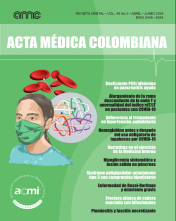An atypical hip fracture associated with bisphosphonate use
Abstract
Introduction: atypical hip and femur fractures have been reported for more than 15 years, some related to the use of bisphosphonates. Although the efficacy of this group of drugs is well established, and it has a favorable risk-benefit ratio, some studies have shown a minimal risk, while others have indicated a clear association, especially with prolonged use of these drugs.
Case presentation: a woman in her 70s was being treated with zoledronate 5 mg/year for five years, and over the last three months had been experiencing pain in the proximal third of her right thigh, with 7-8 intensity on the visual analog scale (VAS), exacerbated by exercise and alleviated by analgesics and rest, and which inhibited her walking. During a hydrotherapy session she experienced pain with a VAS intensity of 10 in her right hip, associated with a feeling of instability. On physical exam, she had pain with movement, shortening, abduction and external rotation of her right lower extremity. An x-ray of her right femur reported a displaced, angled, oblique fracture of the proximal third of the femur, and magnetic resonance imaging of the left femur reported marked regular, circumferential cortical thickening, reaching a thickness of up to 8 mm, with no other findings. Osteosynthesis was performed with a cephalomedullary nail along with insertion of a contralateral prophylactic cephalomedullary nail.
Comments: the current literature suggests that the risk of atypical hip and femur fractures increases with prolonged bisphosphonate use and decreases after stopping the drug, with persistent risk for up to four years. Although the pharmacological and surgical treatment is debated, careful semiology helps clinicians to suspect the condition and perform confirmatory tests. Joint orthogeriatric assessment will help in making decisions and determining the pertinence of prophylactic interventions like the one described in this case.
Metrics
Copyright (c) 2024 CARLOS ALFONSO REYES ORTIZ

This work is licensed under a Creative Commons Attribution 4.0 International License.
Acta Medica Colombiana uses the CC-BY 4.0 license. Authors retain all rights over their work.


